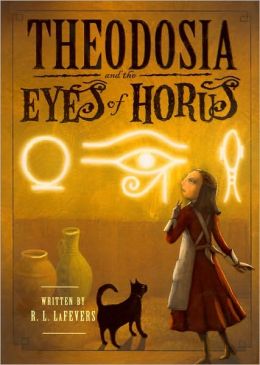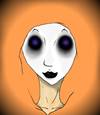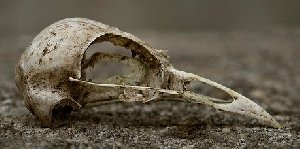
Theodosia & The Eyes of Horus (Book 3)
by R.L. LaFevers
Houghton Mifflin Harcourt, 2011
375 Pages
Middle-Grade (Ages 9-12)
![]()
![]()
Theodosia visits a seedy part of town to see a stage show where a magician named Awi Bubu claims to perform “real Egyptian magic!” Magic that turns out to be identical to the ceremony performed by the Arcane Order of the Black Sun when they were trying to force Theo into showing them her powers (Theodosia and the Staff of Osiris). Within two weeks, Awi Bubu is discovered lurking in Theo’s museum at night!
“If by ‘different,’ little miss means ‘so gifted in her dealings with Egyptian magic,’ then the answer is yes. The time and location of your birth set you on an unusual path. If you had an Egyptian calendar here, I could even tell you the prophecy foretold on the day of your birth.”
The Seven Scorpions, a group of the Black Sun’s who are dedicated to protecting Theodosia from harm, coerce the girl into visiting their secret meeting house to perform another magical ritual. (I am astounded at Aloysious Trawley’s hubris to imagine it acceptable to kidnap one who they believe to be Isis incarnate!) And, oh yeah, the 3rd Assistant Curator, Stilton, has been spying on her.
But similarly, The Brotherhood of the Chosen Keepers isn’t treating their star pupil much better. Clive Fagenbush is harassing Theodosia for regular reports so he can deliver them to Wigmere.
Theodosia’s brother returns from boarding school, and they make a discovery in the cellar of the museum where Theo has been doing inventory while avoiding her grandmother and her plans to conduct a memorial service for the hero, Admiral Sopcoate.
Stilton believes it to be the Tabula Smaragdina, the Emerald Tablet of the alchemists, said to contain the formula to transmute metal into gold. Will he report this to the Black Sun?
Soon enough, Theodosia discovers Aloysious himself and his merry band skulking through her museum. With her having refused to offer them some of her magic, they now believe that she is only capable of using magical objects, not performing magic. But one object from the museum has already been claimed—- Awi Bubu appears and demands the Emerald Tablet! He possesses great power, real magic, and the only thing preventing him from stealing the tablet is Theo’s cat, Isis! He becomes a deep mystery.
Meanwhile, Henry is set upon by the evil restless spirit (or mut) of Tetley, the man mummified as a calling card for the Serpents of Chaos!
While Sniffles, Ratsy, and Sticky Will help Theodosia to make the best of a bad situation by giving Tetley a proper Christian… and Egyptian burial with authentic funerary rites, who should appear but none other than the “late” Admiral Sopcoate, also demanding the Emerald Tablet!
”Are you one of the Wedjadeen?”
Before I finished uttering the word, Awi Bubu sprang across the room, clamped his hand over my mouth, and made a snatching gesture with the other, as if he were plucking the word from the air itself.
We learn that Awi Bubu belongs to yet another fraternal faction, and visit Curator Monk, who acquired an entire warehouse of special artifacts– (Augustus Monk was one of the founders of The Museum of Antiquities,) artifacts of “unknown provenance” that included the Staff of Osiris.
Theodosia gets a few good curses in on Fagenbush, who gets too nosy, and Sticky Will is suspended from the Brotherhood’s order because of Theodosia’s refusal to cooperate with Wigmere’s chain of command.
Grandmother Throckmorton’s house is then burgled of only an emerald necklace, obviously the Serpents sending a message. Can she trust Awi Bubu to help her, or does he represent just another group of selfish children scrambling for a coveted piece of magic treasure?
All the factions come together for a giant melee at the end! Awi Bubu is horribly wounded! Will and Snuffles, Wigmere and Fagenbush, The Serpents of Chaos, Trawley and the Black Sun! And… (Shhh!) the Wedjadeen… all clash!
Ka, Ba:
The ancient Egyptians believed that a human soul was made up of five parts: the Ren, the Ba, the Ka, the Sheut, and the Ib.
Wedjat Eye:
Wadjet was one of the earliest of Egyptian deities, associated with the land and depicted as a snake-headed woman. The Wadjet or Eye of Horus was intended to protect the pharaoh in the afterlife and to ward off evil.
Was Scepter:
The was scepter is a symbol of power that appeared often in relics, art, and hieroglyphics, associated with the gods (such as Set or Anubis) as well as with the pharaoh.
Related Posts:
Theodosia and the Serpents of Chaos
Theodosia and the Staff of Osiris
Theodosia and the Eyes of Horus
Theodosia and the Last Pharaoh



